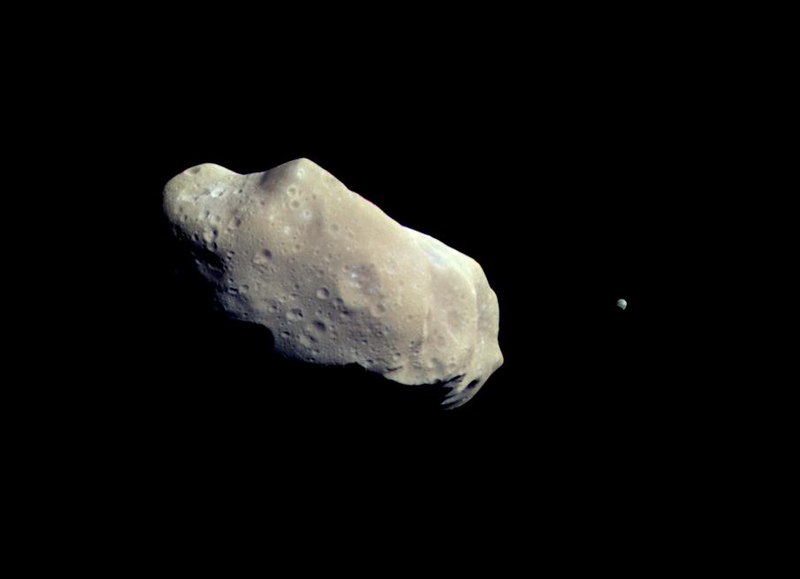File:243 ida.jpg
外觀

預覽大小:800 × 579 像素。 其他解析度:320 × 232 像素 | 640 × 463 像素 | 905 × 655 像素。
原始檔案 (905 × 655 像素,檔案大小:20 KB,MIME 類型:image/jpeg)
檔案歷史
點選日期/時間以檢視該時間的檔案版本。
| 日期/時間 | 縮圖 | 尺寸 | 用戶 | 備註 | |
|---|---|---|---|---|---|
| 目前 | 2022年9月10日 (六) 14:59 |  | 905 × 655(20 KB) | BevinKacon | Reverted to version as of 10:44, 30 January 2006 (UTC) the NASA page clearly states original resolution as Product Size: 905 x 655 pixels (w x h) |
| 2020年7月23日 (四) 09:42 |  | 679 × 491(12 KB) | Leonel Sohns | Recovered old version from archive.org | |
| 2019年4月24日 (三) 18:55 |  | 718 × 520(65 KB) | FriedrichKieferer | Better quality. | |
| 2013年8月11日 (日) 11:46 |  | 718 × 520(17 KB) | Soerfm | Crop | |
| 2006年1月30日 (一) 10:44 |  | 905 × 655(20 KB) | Arnomane | better resolution | |
| 2005年2月1日 (二) 19:52 |  | 679 × 491(12 KB) | Svdmolen | NASA image of 243 Ida and Dactyl. - NASA {{PD}} |
檔案用途
下列68個頁面有用到此檔案:
- EPOXI
- OSIRIS-REx
- 主小行星帶
- 伽利略号探测器
- 伽利略计划
- 先鋒6、7、8和9号
- 先鋒號
- 克萊門汀號
- 凱琳群集
- 半人马号
- 卡蜜拉 (太空船)
- 卡西尼-惠更斯号
- 哈雷艦隊
- 喬托號
- 國際彗星探險者號
- 堂吉诃德小行星防卫任务
- 天問二號
- 天文学名词列表
- 天體
- 太空探測器探測過的微型行星與彗星列表
- 太陽系小天體
- 太陽系探測器列表
- 嫦娥二号
- 客迈拉号
- 小行星
- 小行星25143
- 小行星4179
- 小行星衛星
- 小行星采矿
- 尤利西斯号
- 彗星
- 彗星拦截器
- 彗星號
- 彗星跳跃者
- 新視野二號
- 新视野号
- 星尘号
- 曙光號
- 會合-舒梅克號
- 深度撞击号
- 深空1號
- 火星矿石资源
- 灶神星
- 特洛伊天体
- 神梭计划
- 維加計劃
- 维加1号
- 维加2号
- 羅塞塔號
- 航天年表
- 艾女星
- 艾女星和艾衛表面特徵列表
- 菲萊登陸器
- 螳螂号
- 轮廓号
- 近地天体
- 近拋物線彗星列表
- 隼鸟2号
- 隼鸟号探测器
- 雙小行星改道測試
- 露西號
- 靈神星軌道器
- 非週期彗星列表
- 马克波罗探测器
- User:CYl7EPTEMA777
- Template:小行星任務
- Template:艾女星
- Draft:伽利略号任务
全域檔案使用狀況
以下其他 wiki 使用了這個檔案:
- af.wikipedia.org 的使用狀況
- af.wiktionary.org 的使用狀況
- als.wikipedia.org 的使用狀況
- am.wikipedia.org 的使用狀況
- an.wikipedia.org 的使用狀況
- ar.wikipedia.org 的使用狀況
- ast.wikipedia.org 的使用狀況
- az.wikipedia.org 的使用狀況
- bat-smg.wikipedia.org 的使用狀況
- bcl.wikipedia.org 的使用狀況
- be-tarask.wikipedia.org 的使用狀況
- beta.wikiversity.org 的使用狀況
- be.wikipedia.org 的使用狀況
- bg.wikipedia.org 的使用狀況
- bjn.wikipedia.org 的使用狀況
- bn.wikipedia.org 的使用狀況
- bo.wikipedia.org 的使用狀況
- br.wikipedia.org 的使用狀況
- bs.wikipedia.org 的使用狀況
- ca.wikipedia.org 的使用狀況
- ckb.wikipedia.org 的使用狀況
- co.wikipedia.org 的使用狀況
- cs.wikipedia.org 的使用狀況
檢視此檔案的更多全域使用狀況。



